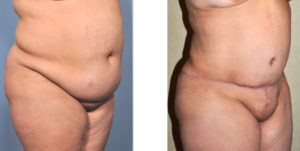
Most importantly, most tummy tucks are significant surgery. You should plan an adequate time for recovery with particular emphasis on how long it will take to return to the type of work you do. Don’t short change yourself. I can make one assumption for most patients…..they don’t have a good idea (why would they?) as to what a tummy tuck operation is like after. Most of us are not as tough as we think. Plan accordingly!
Without question, pain is a common immediate feeling after a tummy tuck. Whether the pain is significant or surprisingly moderate is determined by whether your abdominal fascia (covering of the rectus abdominal muscles) has been tightened down the middle. This is what gives tummy tucks their pain afterwards. Not all tummy tucks are done with muscle tightening. Some can be simple skin and fat cutouts (simple abdominoplasty or panniculectomy) which do not have much discomfort at all. If your plastic surgeon is going to tighten the muscles (which you should know and discuss beforehand), then ask if there will be some type of pain relief offered after surgery such as a 24 or 48 hour pain pump. Pain does get better within a few days but the first week can be a rough one for some patients.
Tummy tucks do not usually have a much swelling and rarely any bruising. If you have a lot of bruising across the abdomen after surgery, call your plastic surgeon. This might be the development of a hematoma. (bleeding) This is of particular concern in the first day or two after surgery. Small insignificant amounts of bruising may appear later but these are not of any concern.
The skin over the stomach area will feel very numb. This numbness will persist for many months and the feeling may take up to a year to come back, particularly down close to the incision area. This occurs as the tiny skin nerves that give feeling to the skin are cut (they can’t be seen) as the upper abdominal skin is raised and stretched down to meet the lower incision. The numbness gradually gets smaller as the feeling comes in from the side, closer to the center and down near the incision. Some patients may have a small area in the center of the incision just above it which may always be numb.
Difficulty standing straight after a tummy tuck is common…if the muscles have been tightened. In those abdominal procedures where muscles are not tightened, then standing straight is not a problem. If the muscles have been tightened and you can stand straight right away…that is a good sign. That will get better by the end of the first week after surgery. This means they have been tightened enough to make a real difference.
Almost all tummy tucks require a drain after surgery. Some plastic surgeons use one drain, others use two. Either way, they will need to stay in place for 7 to 10 days until their fluid output drops considerably. They help immensely in decreasing the risk of a fluid-build-up after surgery under the skin. They are necessary evils of the procedure.
Dr. Barry Eppley
Indianapolis, Indiana


